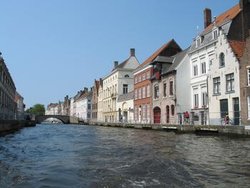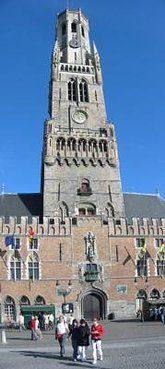Bruges
|
|
- This article is about the city in Belgium. See also Bruges, Gironde, France and Bruges, Pyrénées-Atlantiques, France.

Brugge.jpg
Bruges (Flemish: Brugge (a name probably signifying landing stage)) is the historic capital of West Flanders, Flanders being one of the three regions of Belgium.
The municipality comprises the city of Bruges proper and the towns of Assebroek, Dudzele, Koolkerke, Lissewege, Sint-Andries, Sint-Jozef, Sint-Kruis, Sint-Michiels, Sint-Pieters, Zeebrugge, and Zwankendamme. On January 1, 2004, Bruges had a total population of 117,025 (56,685 males and 60,340 females). The total area is 138.40 km² which gives a population density of 845.54 inhabitants per km².
Bruges is one of Belgium's chief tourist attractions, and was European Capital of Culture in 2002, together with Salamanca. In 1911 the Encyclopaedia Britannica observed that "its medieval appearance is better preserved, as a whole, than in the case of any other Belgian city."
StadhuisBrugge.jpg
| Contents |
History
The history of Bruges begins in a very modest way more than 2000 years ago as a Gallo-Roman settlement. The name Bruges comes from the Old Norse "Bryggja" which means 'landing stage'. The name Bruges appears on documents and coins in the middle of the ninth century. At that time, there was already a strong citadel in Bruges.
Bruges has a long tradition of international port activity. The oldest trade settlement of Bruges and the early medieval port were accessible from the sea until around 1050. A storm flood in 1134 reshaped the Flemish coastal plain: a deep channel appeared, the Zwin, which at the time reached as far as present day Damme. The city remained linked to the sea until the fifteenth century via a canal from the Zwin to Bruges. But Bruges had to use a number of outports, such as Damme and Sluys.

By the eleventh century, Bruges had expanded to become a commercial centre for Europe. With the reawakening of town life in the twelfth century, a wool market, a woollens weaving industry, and the market for cloth all profited from the shelter of city walls, where surpluses could be safely accumulated under the patronage of the counts of Flanders. Bruges was already included in the sequential circuit of the Flemish cloth fairs at the beginning of the thirteenth century. The city's entrepreneurs reached out to make economic colonies of England and Scotland's wool-producing districts. English contacts brought Normandy grain and Gascon wines. Hanseatic ships filled the harbor, which had to be expanded beyond Damme to Sluys to accommodate the new cog-ships, which were round like half walnut shells. In 1277, the first merchant fleet from Genoa appeared in the port of Bruges, first of the merchant colony that made Bruges the main link to the trade of the Mediterranean. This development opened not only the trade in spices from the Levant, but also advanced commercial and financial techniques and a flood of capital that soon took over the banking of Bruges. The Bourse opened in 1309 and developed into the most sophisticated money market of the Low Countries in the fourteenth century. By the time Venetian galleys first appeared, in 1314, they were latecomers. (Braudel 1984)
The population swelled, from some 35,000 inhabitants in 1340 to perhaps 100,000 before 1500, when the natural link between Bruges and the sea silted up, and the port of Antwerp became a rival.
Not every citizen of Bruges floated on the rising economic tide: the differences in income between the tradesmen and the patricians were great. Violent revolts, like those of 1280 and 1436-1438 were roughly suppressed. In the 1302 uprising, the ordinary people took the side of the Count of Flanders against the king of France and the propertied classes. First the French garrison was murdered, in May 1302, and two months later, Bruges took part in the Flemish victory in the Battle of the Golden Spurs on July 11, 1302.
After a decline during the late fourteenth and fifteenth centuries, Bruges recovered to an extent during the sixteenth century. However, the city had lost its leading trade position to Antwerp. The split from the Netherlands in 1584 led to the final decline of Bruges. By 1600, Bruges was a provincial city with a modest maritime reputation.
The first book in English ever printed was published in Bruges by William Caxton. King Charles II of England spent some of his time in exile here.
Reference:
- Braudel, Fernand, The Perspective of the World, vol III of Civilization and Capitalism 1984
Sights
Like Ghent, but on a more concentrated scale, it has most of its medieval architecture intact.
Miscellaneous
Flemish mathematician Simon Stevin (1548-1620) was born in Bruges.
SintSalvatorBrugge.JPG
French NBA player Tony Parker was born in Bruges while his American father was playing professional basketball there.
The fictional character, Dr. Evil from the Austin Powers movie series is also supposed to be from Bruges.
Several beers come from Bruges: Brugse Tripel (blond beer) and Brugs (white beer, brewed by Alken-Maes).
Bruges is also a football town represented by two teams at the top level (Jupiler League): Club Brugge and Cercle Brugge K.S.V.
Bruges is home to the College of Europe, a prestigious institution of postgraduate studies in European Economics, Law and Politics.
Transportation
Although a few streets are restricted, no part of Brugge is truly carfree--as any local bicyclist (and there are tens of thousands) will attest. Only cabs and buses may cross the main markt, and driving in Bruges is beastly difficult due to numerous one ways, but cars are everywhere. The cars are required by law to yield to pedestrians and bicyclists, but like everywhere else, some cars and cabs drive aggressively in regard to bicycles. Plans have long been underway to ban cars altogether from the center of Brugge or to restrict traffic much more than it currently is, but these plans have come to nothing. Recently (2005) signs have been changed for the convenience of bicyclists, allowing two-way bike traffic on more streets. But car traffic has not decreased. Recent bicycle fatalities have increased pressure to close bridges and further restrict inner Brugge, but laws have not yet passed. Also, due to heavily populated suburbs, bus traffic is high on the narrow streets. This makes cycling even trickier.
Tourists are encouraged to enter Brugge by train or to use carparks. However, as these carparks are within the egg (the main circle of canals) this is only a partial solution, or no solution at all for those living or cycling or walking near the carparks. If you park on the streets, close your mirrors or you will lose them.
See also
External link
- Official Website (http://www.brugge.be/) Information available in Dutch, French, English, and German
- VisitBruges.tv : online video of Bruges (http://www.visitBruges.tv/)
- Photos of Bruges - Terra Galleria (http://terragalleria.com/europe/belgium/bruges)
Template:Commonsbg:Брюж da:Brügge de:Brügge es:Brujas eo:Bruĝo fr:Bruges nl:Brugge ja:ブリュッヘ no:Brugge nds:Brügge pl:Brugia sl:Brugge
